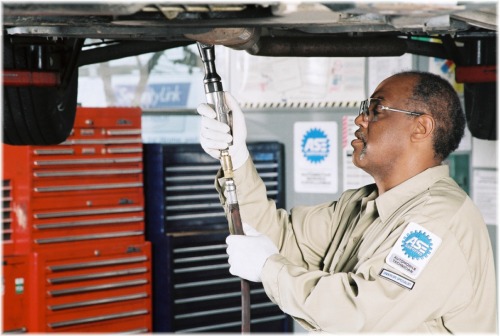
There are more vehicles on U.S. roads than ever before. With an estimated 204 million cars and light trucks crowding our roads as of 2001, your safety and that of others is at risk when your vehicle isn’t stopping and steering at its best. Reducing your vehicle’s stopping distance by just an inch or so could make the difference between a minor scare and a major fender bender. Crowded roads aren’t the only concern. The roads themselves are often in a sorry state of repair. Portions of our highway system (including many bridges) haven’t seen much in the way of maintenance or repair since they were built. In cold climates, the freeze/thaw cycle enlarges cracks and holes in the pavement. In sunnier spots, the heat, heavy cargo hauling and years of neglect take their own toll on roads. The result can be a moonscape of potholes that can affect the handling of your vehicle. Bad roads can cause suspension components, so vital to steering control and handling, to grow old before their time. Most drivers don’t spend much time thinking about the automotive professionals who service their vehicle’s suspension systems, but you don’t have to be an automotive expert to keep your vehicle’s stopping and steering systems safe.
An Epidemic of Unperformed Maintenance
While the following estimates simply illustrate how widespread unperformed maintenance is, consider this:
In the Automotive Industry Status Report 2001 published by the Motor & Equipment Manufacturers Association (MEMA), analysts pegged unperformed vehicle maintenance across the entire fleet in terms of retail dollars ($58.3 billion)
Arbitrarily dividing this dollar amount by an assumed (and generous) average repair cost of $300 per vehicle across the entire car and light truck fleet potentially indicates that 194.3 million vehicles need some type of maintenance and repair
Amazingly, this suggests that over 95 percent of the entire passenger car and light truck fleet suffers from some form of unperformed maintenance. This leaves only 9.7 million vehicles (less than 5 percent) that don’t. If your vehicle is over five years old, the likelihood that it needs maintenance service of any type soars higher.
Nip Repair Costs Before They Bury You
Putting off repairs for too long results in growing costs. For a typical brake job, you’ll have to buy not only new brake pads, but new brake rotors as well to replace the ones that were ruined by procrastinating. The price for a new rotor ranges from $50 to $250 or so, depending upon the vehicle application — and that’s for each wheel. The old adage couldn’t be truer: Pay a little now or a lot later. Even if normal wear dictates rotor replacement, the upside is that it could be the last time you’ll ever replace them before you trade in the vehicle. It’s important to perform needed maintenance early. Allowing the situation to bloom into an expensive repair threatens the practicality of keeping your paid-for wheels on the road. If you made 36, 48 or even 60 monthly payments without flinching in order to buy the car, but don’t like to pay for maintenance, try considering it as a short-term “car payment” that only has to be made occasionally.
Safety tips for brake service:
Invest in a top-quality pad.
If any rotors are marginal for continued service after refinishing (too thin or very close to the minimum thickness specification), have them replaced. The technician can compare the specification dimension and your rotors’ actual thickness for you on request. If you own an older vehicle equipped with Original Equipment rotors, be prepared to replace them at this time.
Have the brake calipers inspected to ensure that any moving parts (such as their slides and bleeder screws) haven’t corroded and frozen up Don’t always jump at the lowest quoted price for your brake job. A low price quote can mean that you’re not getting the complete brake system serviced. Beyond basic brake pads and rotor replacement or resurfacing, ask for quotations on the following expanded parts and services for your older vehicle:
If your brake hydraulic system has never been flushed, have it serviced to remove moisture and impurities from the reservoir, lines, calipers and/or wheel cylinders.
Have rubber-type flex brake hoses replaced when they’re hard, cracked or simply old.
When rotors are being resurfaced for reuse, request inspection of the wheel bearings. On rear-wheel-drive cars or trucks, have the front wheel bearings inspected and repacked with new grease, along with replacing the seals- don’t take the chance of being stranded over an inexpensive bearing or seal.
For drum brake applications, ask to have a new brake hardware kit installed when the brake shoes are replaced and the drums are refinished. The technician should ensure that each assembly’s wheel cylinder pistons, starwheel adjuster and bleeder screw aren’t sticking or seized.
Have your emergency brake assembly tested periodically. Have it repaired or adjusted if necessary.
This approach to vehicle maintenance may cost a little more up front, but if you make the investment now, you can be sure that – old or new – your car or truck will stop in the shortest distance possible – and be able to steer around trouble. If your vehicle is over five years old and has only had brake pad and rotor servicing in the past, it’s generally appropriate to have these items serviced or replaced. Remember, there are cheap jobs that use basic components; there are also more-expensive jobs that use premium components. What’s the cost difference between the two? Which one would you trust most?

